Global Digital Map Market: By Mapping Type, By Offering, By Purpose, By Scale, By Application, By Industry, By Region & Segmental Insights Trends and Forecast, 2024 – 2034
- Industry: Technology
- Report ID: TNR-110-1090
- Number of Pages: 420
- Table/Charts : Yes
- May, 2024
- Base Year : 2024
- No. of Companies : 10+
- No. of Countries : 29
- Views : 10193
- Covid Impact Covered: Yes
- War Impact Covered: Yes
- Formats : PDF, Excel, PPT
A digital map is a representation of geographic data in a digital format that can be viewed, manipulated, and analysed using computers or electronic devices. It typically consists of layers of information such as roads, buildings, landmarks, geographic features, and other spatial data, which are organized and displayed visually on a digital platform.
Digital maps are widely used for navigation purposes, both in personal navigation devices and mobile applications. They provide turn-by-turn directions, real-time traffic information, and points of interest to help users navigate from one location to another. Digital maps serve as the foundation for Geographic Information Systems (GIS), which are used for spatial analysis, mapping, and decision-making in various fields such as urban planning, environmental management, agriculture, and public safety.
Many mobile applications and services utilize digital maps to offer location-based services such as finding nearby restaurants, businesses, events, and services based on the user’s current location. Digital maps are used for asset tracking and management, allowing businesses to monitor the location and status of vehicles, equipment, and other assets in real-time.
In terms of revenue, the global digital map market was worth US$ 27.9 Bn in 2023, anticipated to witness CAGR of 11.6% During 2024 – 2034.
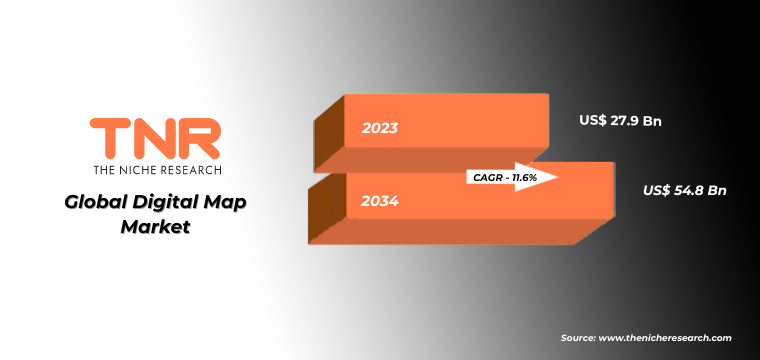
Global Digital Map Market Key Dynamics
Rapid Urbanization and Infrastructure Development: Urbanization and infrastructure development projects worldwide drive the demand for digital mapping solutions in urban planning, land management, transportation planning, and infrastructure development. Digital maps play a crucial role in visualizing, analyzing, and managing spatial data to support sustainable urban growth and infrastructure expansion.
Growing Demand for Location-Based Services (LBS): The proliferation of smartphones, mobile applications, and Internet of Things (IoT) devices fuels the demand for location-based services (LBS) that rely on digital maps for navigation, real-time traffic updates, local business searches, and personalized recommendations. The increasing adoption of LBS across various industries, including automotive, retail, healthcare, and logistics, drives the growth of the digital map market.
Emergence of Autonomous Vehicles: The development and commercialization of autonomous vehicles (AVs) rely heavily on high-definition digital maps for accurate localization, path planning, and real-time situational awareness. As the automotive industry advances towards autonomous driving technology, the demand for detailed and precise digital maps capable of supporting AV navigation and decision-making continues to rise.
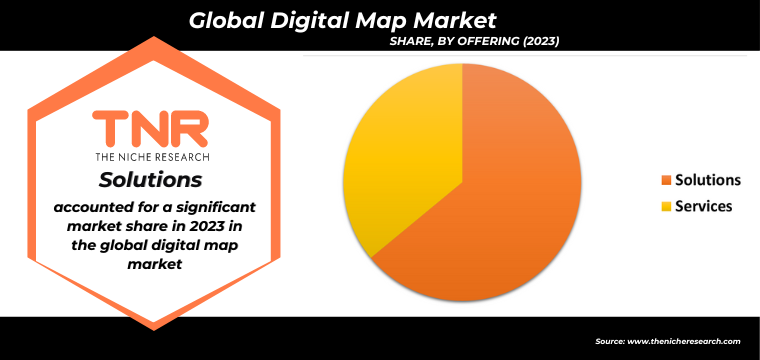
Solutions Segment Dominated the Global Digital Map Market During the Forecast Period (2024 – 2034).
The widespread adoption of smartphones and mobile devices has increased the demand for web mapping and GPS-enabled services. Consumers rely on web mapping applications and GPS navigation apps for real-time location tracking, turn-by-turn directions, and location-based recommendations for nearby businesses, attractions, and services. Continuous advancements in mapping technologies, such as satellite imagery, aerial photography, LiDAR (Light Detection and Ranging), and GPS (Global Positioning System), drive the demand for mapping data and GPS-enabled services. These technologies enable the creation of more accurate, detailed, and up-to-date maps, facilitating various applications in navigation, location-based services, and spatial analysis.
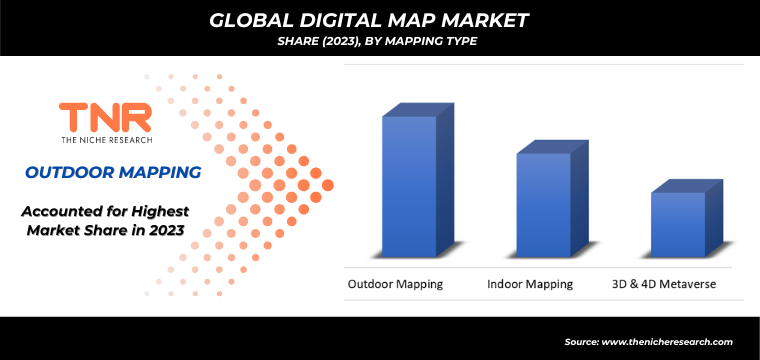
Outdoor Mapping Segment Had the Highest Share in the Global Digital Map Market in 2023.
Adventure tourism, including activities like mountaineering, trekking, and wilderness exploration, relies heavily on accurate outdoor mapping solutions. Digital maps equipped with terrain information, elevation data, and points of interest are essential for guiding adventure tourists through rugged terrain and remote landscapes safely. With the increasing popularity of outdoor recreational activities such as hiking, camping, cycling, and off-road driving, there is a growing demand for digital maps that provide accurate and detailed information about outdoor trails, parks, and recreational areas.
Outdoor enthusiasts rely on digital maps to plan their trips, navigate trails, and discover new outdoor destinations. Geocaching and orienteering are outdoor recreational activities that involve using GPS coordinates and digital maps to find hidden containers or navigate through designated checkpoints. The popularity of these activities has led to a demand for digital maps that support geocaching and orienteering adventures by providing accurate location data and waypoint navigation.
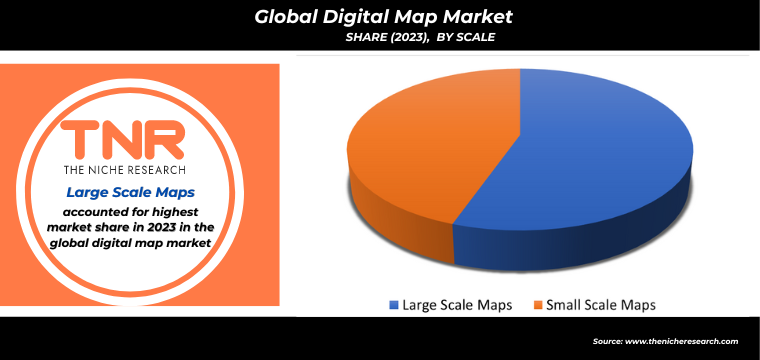
Routing and Navigation Application had the Highest Share in the Global Digital Map Market in 2023.
The popularity of on-demand services such as ride-sharing, food delivery, and parcel delivery has created a demand for accurate routing and navigation solutions. Digital maps enable service providers to optimize routes, minimize delivery times, and enhance the overall customer experience by providing timely and efficient service. As urban areas continue to grow, there is an increasing need for efficient routing and navigation solutions to manage traffic congestion, optimize transportation routes, and improve mobility within cities.
Digital maps provide real-time traffic information and navigation guidance to help commuters navigate busy urban environments more effectively. The rise in e-commerce industry has propelled the demand for last-mile delivery solutions. Digital maps play a crucial role in route planning and navigation for delivery drivers, helping them find the shortest and fastest routes to customers’ doorsteps, reducing delivery times, and improving operational efficiency for e-commerce companies.
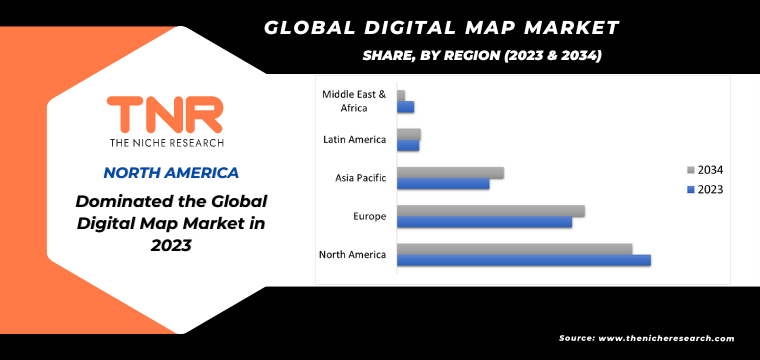
North America Registered Highest Market Share in 2023 in the Global Digital Map Market.
North America’s vast network of roads, highways, and transportation infrastructure relies heavily on digital maps for route planning, navigation, and logistics optimization. Digital maps play a crucial role in the transportation and logistics industry by providing real-time traffic information, route guidance, and fleet management solutions for trucking companies, logistics providers, and delivery services. Many cities in North America are implementing smart city initiatives aimed at improving sustainability, efficiency, and quality of life for residents.
Digital maps with advanced routing and navigation capabilities are essential components of smart city projects, enabling municipalities to optimize public transportation, manage traffic congestion, and enhance urban mobility through data-driven decision-making. The growth of e-commerce in North America has led to increased demand for efficient last-mile delivery solutions. Digital maps enable e-commerce companies and delivery service providers to optimize delivery routes, reduce delivery times, and improve customer satisfaction by providing accurate and reliable navigation guidance for drivers.
Competitive Landscape: Global Digital Map Market:
- Apple
- Caliper
- Emapa
- Esri
- HERE Technologies
- Inpixon
- INRIX
- LightBox
- Maxar Technologies
- Microsoft
- NearMap
- ServiceNow
- TomTom
- Other Market Participants
Global Digital Map Market: Key Takeaways
| Report Specifications | Details |
| Market Revenue in 2023 | US$ 27.9 Bn |
| Market Size Forecast by 2034 | US$ 54.8 Bn |
| Growth Rate (CAGR) | 11.6% |
| Historic Data | 2016 – 2022 |
| Base Year for Estimation | 2023 |
| Forecast Period | 2024 – 2034 |
| Report Inclusions | Market Size & Estimates, Market Dynamics, Competitive Scenario, Trends, Growth Factors, Market Determinants, Key Investment Segmentation, Product/Service/Solutions Benchmarking |
| Segments Covered | By Mapping Type, By Offering, By Purpose, By Scale, By Application, By Industry |
| Regions Covered | North America, Europe, Asia Pacific, Middle East & Africa, Latin America |
| Countries Covered | U.S., Canada, Mexico, Rest of North America, France, The UK, Spain, Germany, Italy, Nordic Countries (Denmark, Finland, Iceland, Sweden, Norway), Benelux Union (Belgium, The Netherlands, Luxembourg), Rest of Europe, China, Japan, India, New Zealand, Australia, South Korea, Southeast Asia (Indonesia, Thailand, Malaysia, Singapore, Rest of Southeast Asia), Rest of Asia Pacific, Saudi Arabia, UAE, Egypt, Kuwait, South Africa, Rest of Middle East & Africa, Brazil, Argentina, Rest of Latin America |
| Key Players | Apple, Caliper, Emapa, Esri ,Google ,HERE Technologies, Inpixon ,INRIX, LightBox, Maxar Technologies, Microsoft, NearMap, ServiceNow, TomTom , Other Market Participants |
| Customization Scope | Customization allows for the inclusion/modification of content pertaining to geographical regions, countries, and specific market segments. |
| Pricing & Procurement Options | Explore purchase options tailored to your specific research requirements |
| Contact Details | Consult With Our Expert
Japan (Toll-Free): +81 663-386-8111 South Korea (Toll-Free): +82-808- 703-126 Saudi Arabia (Toll-Free): +966 800-850-1643 United Kingdom: +44 753-710-5080 United States: +1 302-232-5106 E-mail: askanexpert@thenicheresearch.com
|
Global Digital Map Market
By Mapping Type
- Outdoor Mapping
- Indoor Mapping
- 3D & 4D Metaverse
By Offering
- Solutions
- Mapping Data
- Web Mapping
- GPS-enabled Services
- Geographic Information System (GIS) Services
- Services
- Consulting
- Support & Maintenance
- Deployment & Integration
By Purpose
- Navigation Maps
- Thematic Maps
- Satellite Imagery
- Real-Time Traffic Maps
By Scale
- Large Scale Maps
- Small Scale Maps
By Application
- Real-Time Location Data Management
- Geocoding and Geo-positioning
- Routing and Navigation
- Asset Tracking
- Reverse Geocoding
- Other Application
By Industry
- Government & Defense
- Infrastructure Development & Construction
- Travel, Transportation, & Logistics
- Automotive
- Retail
- Finance & Insurance
- Manufacturing
- Energy, Utility, & Natural Resources
- Other
By Region
- North America (U.S., Canada, Mexico, Rest of North America)
- Europe (France, The UK, Spain, Germany, Italy, Nordic Countries (Denmark, Finland, Iceland, Sweden, Norway), Benelux Union (Belgium, The Netherlands, Luxembourg), Rest of Europe)
- Asia Pacific (China, Japan, India, New Zealand, Australia, South Korea, Southeast Asia (Indonesia, Thailand, Malaysia, Singapore, Rest of Southeast Asia), Rest of Asia Pacific)
- Middle East & Africa (Saudi Arabia, UAE, Egypt, Kuwait, South Africa, Rest of Middle East & Africa)
- Latin America (Brazil, Argentina, Rest of Latin America)
Report Layouts:
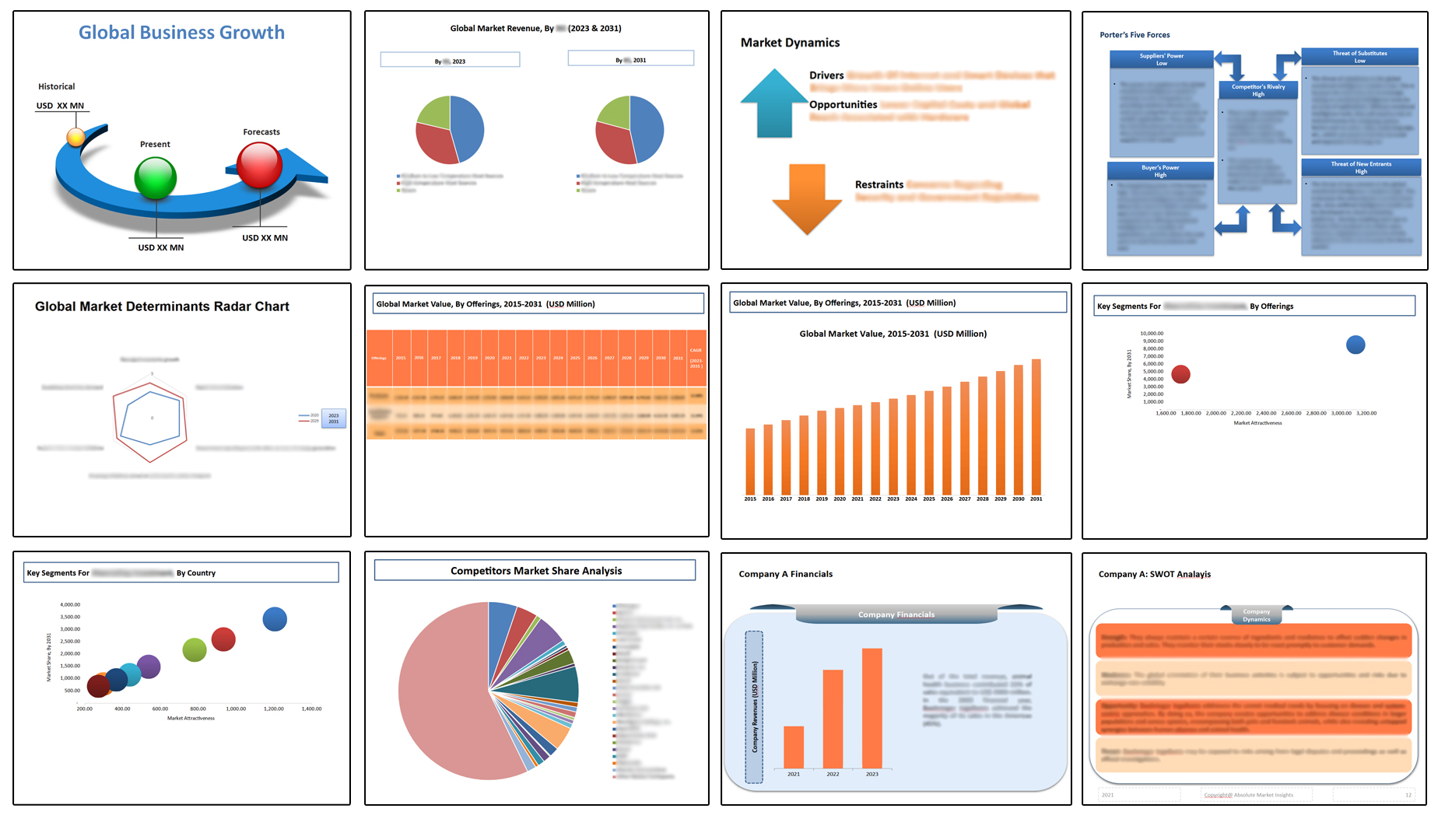
Table of Contents
**Exclusive for Multi-User and Enterprise User.
Global Digital Map Market
By Mapping Type
- Outdoor Mapping
- Indoor Mapping
- 3D & 4D Metaverse
By Offering
- Solutions
- Mapping Data
- Web Mapping
- GPS-enabled Services
- Geographic Information System (GIS) Services
- Services
- Consulting
- Support & Maintenance
- Deployment & Integration
By Purpose
- Navigation Maps
- Thematic Maps
- Satellite Imagery
- Real-Time Traffic Maps
By Scale
- Large Scale Maps
- Small Scale Maps
By Application
- Real-Time Location Data Management
- Geocoding and Geo-positioning
- Routing and Navigation
- Asset Tracking
- Reverse Geocoding
- Other Application
By Industry
- Government & Defense
- Infrastructure Development & Construction
- Travel, Transportation, & Logistics
- Automotive
- Retail
- Finance & Insurance
- Manufacturing
- Energy, Utility, & Natural Resources
- Other
By Region
- North America (U.S., Canada, Mexico, Rest of North America)
- Europe (France, The UK, Spain, Germany, Italy, Nordic Countries (Denmark, Finland, Iceland, Sweden, Norway), Benelux Union (Belgium, The Netherlands, Luxembourg), Rest of Europe)
- Asia Pacific (China, Japan, India, New Zealand, Australia, South Korea, Southeast Asia (Indonesia, Thailand, Malaysia, Singapore, Rest of Southeast Asia), Rest of Asia Pacific)
- Middle East & Africa (Saudi Arabia, UAE, Egypt, Kuwait, South Africa, Rest of Middle East & Africa)
- Latin America (Brazil, Argentina, Rest of Latin America)
The Niche Research approach encompasses both primary and secondary research methods to provide comprehensive insights. While primary research is the cornerstone of our studies, we also incorporate secondary research sources such as company annual reports, premium industry databases, press releases, industry journals, and white papers.
Within our primary research, we actively engage with various industry stakeholders, conducting paid interviews and surveys. Our meticulous analysis extends to every market participant in major countries, allowing us to thoroughly examine their portfolios, calculate market shares, and segment revenues.
Our data collection primarily focuses on individual countries within our research scope, enabling us to estimate regional market sizes. Typically, we employ a bottom-up approach, meticulously tracking trends in different countries. We analyze growth drivers, constraints, technological innovations, and opportunities for each country, ultimately arriving at regional figures.Our process begins by examining the growth prospects of each country. Building upon these insights, we project growth and trends for the entire region. Finally, we utilize our proprietary model to refine estimations and forecasts.
Our data validation standards are integral to ensuring the reliability and accuracy of our research findings. Here’s a breakdown of our data validation processes and the stakeholders we engage with during our primary research:
- Supply Side Analysis: We initiate a supply side analysis by directly contacting market participants, through telephonic interviews and questionnaires containing both open-ended and close-ended questions. We gather information on their portfolios, segment revenues, developments, and growth strategies.
- Demand Side Analysis: To gain insights into adoption trends and consumer preferences, we reach out to target customers and users (non-vendors). This information forms a vital part of the qualitative analysis section of our reports, covering market dynamics, adoption trends, consumer behavior, spending patterns, and other related aspects.
- Consultant Insights: We tap into the expertise of our partner consultants from around the world to obtain their unique viewpoints and perspectives. Their insights contribute to a well-rounded understanding of the markets under investigation.
- In-House Validation: To ensure data accuracy and reliability, we conduct cross-validation of data points and information through our in-house team of consultants and utilize advanced data modeling tools for thorough verification.
The forecasts we provide are based on a comprehensive assessment of various factors, including:
- Market Trends and Past Performance (Last Five Years): We accurately analyze market trends and performance data from preceding five years to identify historical patterns and understand the market’s evolution.
- Historical Performance and Growth of Market Participants: We assess the historical performance and growth trajectories of key market participants. This analysis provides insights into the competitive landscape and individual company strategies.
- Market Determinants Impact Analysis (Next Eight Years): We conduct a rigorous analysis of the factors that are projected to influence the market over the next eight years. This includes assessing both internal and external determinants that can shape market dynamics.
- Drivers and Challenges for the Forecast Period:Identify the factors expected to drive market growth during the forecast period, as well as the challenges that the industry may face. This analysis aids in deriving an accurate growth rate projection.
- New Acquisitions, Collaborations, or Partnerships: We keep a close watch on any new acquisitions, collaborations, or partnerships within the industry. These developments can have a significant impact on market dynamics and competitiveness.
- Macro and Micro Factors Analysis:A thorough examination of both macro-level factors (e.g., economic trends, regulatory changes) and micro-level factors (e.g., technological advancements, consumer preferences) that may influence the market during the forecast period.
- End-User Sentiment Analysis: To understand the market from the end-user perspective, we conduct sentiment analysis. This involves assessing the sentiment, preferences, and feedback of the end-users, which can provide valuable insights into market trends.
- Perspective of Primary Participants: Insights gathered directly from primary research participants play a crucial role in shaping our forecasts. Their perspectives and experiences provide valuable qualitative data.
- Year-on-Year Growth Trend: We utilize a year-on-year growth trend based on historical market growth and expected future trends. This helps in formulating our growth projections, aligning them with the market’s historical performance.
Research process adopted by TNR involves multiple stages, including data collection, validation, quality checks, and presentation. It’s crucial that the data and information we provide add value to your existing market understanding and expertise. We have also established partnerships with business consulting, research, and survey organizations across regions and globally to collaborate on regional analysis and data validation, ensuring the highest level of accuracy and reliability in our reports.









